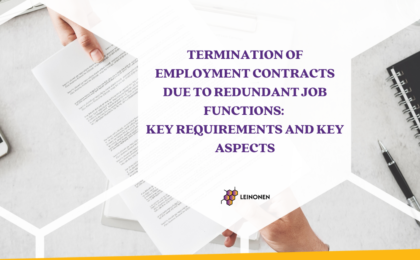Currently there are two types of taxes which are calculated from the salary stated in the employment agreement, i.e. „employee‘s taxes“ and „employer‘s taxes“:
· „employee‘s taxes“ are taxes which are deducted from the salary indicated in the employment agreement:
o 15% personal income tax (PIT);
o 9% social security contributions;
o 2% transfer to pension funds (calculated only if the employee chooses to transfer).
· „employer‘s taxes“ are taxes which are calculated on top of the gross salary:
o 30,48%-33,50% social security contributions;
o 0,7% guarantee fund and long-term unemployment fund.
Therefore, the total price of working place consists of the gross salary amount indicated in the employment contract and additionally calculated “employer’s taxes”.
From 2019 it was decided to make most of the taxes to be deducted from the gross salary agreed, i.e. from 2019 the taxes will be:
· „employee‘s taxes“ are taxes which are deducted from the salary indicated in the employment agreement:
o 20% or 27% PIT;
o 19,50% social security contributions;
o 1,8% – 3% transfer to pension funds (calculated only if the employee chooses to transfer).
· „employer‘s taxes“ are taxes which are calculated on top of the gross salary:
o 1,45% social security contributions;
o 0,32% guarantee fund and long-term unemployment fund.
In order to ensure that the net salary earned by the employees would not be negatively affected by the changes in tax system, the employers will be obliged to recalculate gross salary of employees. On 1 January 2019 the gross salary would have to be recalculated by multiplying current gross salary by the coefficient of 1,289.
In part I below we present an example, how the salary, its taxes and total costs of working place would look like based on the current legislation and the legislation which comes into force from 1 January 2019.
As well the following changes will be implemented from 1 January 2019:
· ceilings for social security contributions are introduced (more information in part II);
· progressive PIT is introduced (more information in part III);
· nontaxable income amounts are changed (more information in part IV).
I. The example of salary calculation
Below we provide an example, how salary calculation would look like based on the current legislation and the legislation which comes into force from 1 January 2019.
The example is prepared on the assumption, that the employee has not chosen to transfer funds to pension funds and that the employee is not a limited working capacity person.
Comparative data of salary, EUR | |||
|
| 2018 | 2019 |
Gross salary | More information | 1000,00 | 1289,00 |
Untaxable income amount | Part IV | 80,00 | 189,90 |
PIT | Part III | 138,00 | 219,82 |
Social security contributions (employee‘s) | Part II | 90,00 | 251,36 |
Net salary |
| 772,00 | 817,82 |
Social security contributions (employer‘s) | Part II | 304,80 | 18,69 |
Guarantee fund and long-term unemployment fund | Part II | 7,00 | 4,12 |
Total costs of working place |
| 1311,80 | 1311,81 |
As you can see from the table above, the total costs of working place are changing only marginally.
II. Social security contribution
The main changes regarding the social security contribution are:
· changes in the „employee‘s“ and the „employer‘s“ tax rates;
· implementation of social security contribution ceilings.
In the table below, we provide comparative information about current social security contribution rates and their changes from 2019.
| Social security contribution (employee‘s) | Transfer to pension funds (voluntary) | Social security contribution (employer‘s) | Guarantee fund and long-term unemployment fund | Ceilings to social insurance contribution (except 6,98% of health insurance) |
Till 31.12.2018 | 9% | 2% | 30,48% – 33,50% | 0,7% | N/A |
From 01.01.2019 | 19,50% | 1,8% or 3% | 1,45% | 0,32% | Part of employment income exceeding 120 average monthly salaries |
From 01.01.2020 | 19,50% | 2,1% or 3% | 1,45% | 0,32% | Part of employment income exceeding 84 average monthly salaries |
From 01.01.2021 | 19,50% | 2,4% or 3% | 1,45% | 0,32% | Part of employment income exceeding 60 average monthly salaries |
From 01.01.2022 | 19,50% | 2,7% or 3% | 1,45% | 0,32% | Part of employment income exceeding 60 average monthly salaries |
From 01.01.2023 | 19,50% | 3% | 1,5% | 0,32% | Part of employment income exceeding 60 average monthly salaries |
III. PIT
The main changes related to PIT are:
· PIT rate change;
· implementation of progressive 27% PIT.
In the table below, we provide comparative information about current PIT rates and their changes from 2019.
| Standard PIT | Progressive PIT | When progressive PIT is applied? |
Till 2018.12.31 | 15% | N/A | N/A |
From 2019.01.01 | 20% | 27% | Part of employment income exceeding 120 average monthly salaries* |
From 2020.01.01 | 20% | 27% | Part of employment income exceeding 84 average monthly salaries* |
From 2021.01.01 | 20% | 27% | Part of employment income exceeding 60 average monthly salaries* |
*illness, maternity, paternity, parental leave pays and payments from long-term unemployment fund are not included into income from which progressive PIT is calculated.
IV. Nontaxable income amount
From 2019 there are changes of untaxable income amount applicable to the employees of limited working capacity and as well changes in the variable untaxable amount.
In the table below, we provide comparative information about current untaxable income amounts and their changes from 2019.
| Variable monthly nontaxable income amount (MUIA) (formula) | Nontaxable income amount for limited working capacity employees | |
0-25% | 30-55% | ||
Till 2018.12.31 | MUIA=380-0.50*(MEI-MMS) | EUR 450 | EUR 390 |
From 2019.01.01 | MUIA=300-0.15*(MEI-MMS) | EUR 353 | EUR 308 |
From 2020.01.01 | MUIA=400-0.20*(MEI-MMS) | EUR 453 | EUR 408 |
From 2021.01.01 | MUIA=500-0.23*(MEI-MMS) | EUR 553 | EUR 508 |
The following abbreviations are used in formula:
MEI – monthly employment income;
MMS – minimum monthly salary, valid at 1 January of the year.
Till 31 December 2018 relevant institutions should implement additional legislation related to the changes described above. We will inform about the actual legislation implemented in our website leinonen.eu.
Please do not hesitate to contact us if you have any questions regarding the legislation changes.



